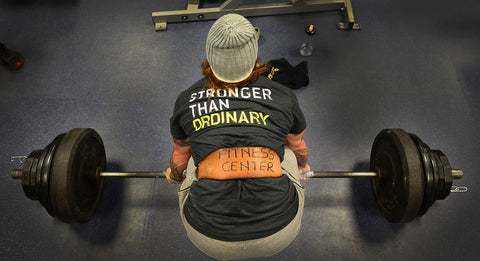German Volume Training (GVT) is a training technique used by Olympic lifters, bodybuilders and powerlifters in order to gain mass and break plateaus.
But what is German Volume Training? How to start using it? What are the benefits? What's an example of a German Volume Training split?
Today I'll answer these questions and show you how to start incorporating German volume training into your own routine.
Let's get started.
German Volume Training Origins
German Volume Training gained popularity in 1996 after it was discussed in the Muscle Media 2000 magazine by Charles Polliquin. However, German Volume Training is much older than that, since '96 is when it gained popularity, not when it was created. In fact, versions of the training were used as far back as the nineteen forties. So basically, German Volume Training involves 10 sets of compound lifts where the individual needs to do 10 reps each set for a total of 100 reps.
German Volume Training also means you need to use decent weights. When you finally reach the point where you're able to do 10 sets of 10 using the same weight, it's time to increase the weight. You can use this system with a single exercise only and that exercise should be a compound exercise. Some examples include overhead presses, barbell rows, squats and also bench presses.
For example, let's consider that you'd like to increase your squat. You choose a weight you're comfortable with for 20 repetitions. You then load the weight on the bar and start doing your first set of 10 repetitions.
Now you need to rest between 60 to 90 seconds and then start doing the second set. Again, you rest and then start the third set and so forth until you cannot do 10 repetitions anymore or you get all the 10 repetitions on each of the 10 sets. Once you manage that, you can increase the weight for your next training.
Let's view this in a training log. So the lifter can do 185pounds on squat for twenty reps. As a result, he'll use 185 lbs on all ten sets.
German Volume Training Goals and Guidelines
The main goal of German Volume Training training is to make sure that you complete 10 sets of 10 reps using the same weight for every exercise you consider.

Start with a weight you'll easily be able to lift for twenty repetitions until failure if you would have to. For the majority of individuals on most exercises, that's going to be about sixty percent of their 1RM load. So if you bench pressed 300 lbs for one repetition, then you'd use 180 lbs for this particular exercise.
German Volume Training Split
New to german volume training? Start with this split:
- Day One Back and chest.
- Day Two: Abs and legs.
- Day Three: Off.
- Day Four: Shoulders and arms.
- Day Five: Off.
Keep a journal of your training. Don't just record weights, but also rest periods and tempo.
Day 1: Chest and Back
Barbell Bench Press (Medium Grip): 10 Sets: 10 Reps & 90s rest
Bent Over Barbell Row: 10 Sets: 10 Reps, 90s rest
Cable Crossover: 3 Sets: 10 Reps, 60s rest
Close-Grip Front Lat Pulldown: 3 Sets: 10 Reps, 60s rest
Day 2: Abs and Legs
Barbell Squat: 10 Sets: 10 Reps, 90s rest
Lying Leg Curls: 10 Sets: 10 Reps, 90s rest
Seated Calf Raise: 3 Sets: 10 Reps, 60s rest
Hanging Leg Raise: 3 Sets: 10 Reps, 60s rest
Day 3: Off
Day 4: Shoulders and Arms
Smith Machine Close-Grip Bench Press: 10 Sets: 6 Reps, 90s rest
Barbell Curl: 10 Sets: 6 Reps, 90s rest
Side Lateral Raise: 3 Sets: 6 Reps, 60s rest
Seated Bent-Over Rear Deltoids Raise: 3 Sets: 6 Reps, 60s rest
Day 5: Rest
You should finish this routine in 6 weeks.
What's Next?
After one and a half months you'll need to reduce the intensity a bit. You'll need to consider different exercises and do ten sets of six repetitions. Here's an example of how you can go about this.
Advanced German Volume Training

If you're an advanced trainee, then you should know that variety is very important if you want to make sure you're going to achieve your fitness goals as fast as you planned to. For this purpose, we're going to use the 4% method, meaning that we're going to increase the load between four to five percent every workout for consecutive 2 workouts. We're also going to cut the target repetition by a single repetition for every weight increase. Then you can reduce the weight 4% to 5% and increase the repetition bracket to the number you've started out with.
So let's consider that you can barbell curl one hundred lbs for twelve strict repetitions and so far you couldn't increase the number of reps on this particular workout. To increase your curling strength though, be sure to use the following tips:
Barbell Curl Routine Example
- 10 x 6 150 lbs
- 10 x 5 115 lbs
- 10 x 4 120 lbs
- 10 x 6 115 lbs
- 10 x 5 120 lbs
- 10 x 4 120 lbs
After completing this training, you'll be able to curl one hundred and twenty lbs for twelve repetitions. That is a nine percent gain over just six workouts!
Here's another example with how you can use the German Volume Training method with the 4 to 5% method if you can bench press three hundred lbs ten times in strict form.
Bench Press Routine Example:
Barbell Bench Press (Medium Grip)
- 10 x 5 300 lbs
- 10 x 4 315 lbs
- 10 x 3 330 lbs
- 10 x 315 lbs
- 10 x 4 330 lbs
- 10 x 3 345 lbs
- 10 x 300 lbs
German Volume Training & Injuries
There are many who'd like to consider this training in order to improve their strength and overall fitness level, but what happens if you injured your wrist? Well, the truth is that you can actually replace the barbells with dumbbells and you'd actually get similar results. Just make sure that you do the exercises correctly and you'll undoubtedly reap their benefits.




